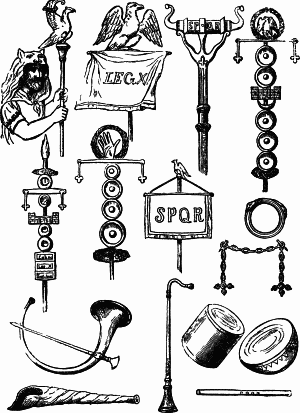Roman military personal equipment
Roman Military Personal Equipment
Roman military personal equipment evolved over centuries, reflecting the changes in technology and tactics used by the Roman Army. The equipment provided protection and offensive capabilities to the legionaries and auxiliaries that formed Rome's formidable military forces. This article outlines the key components of Roman military gear, including armor, weapons, and other essential items.
Armor[edit | edit source]
Lorica Segmentata[edit | edit source]
The Lorica Segmentata is perhaps the most iconic type of Roman armor. It consisted of metal strips (segmentata meaning segmented), fastened to internal leather straps. This design offered excellent protection and flexibility. The armor was primarily used during the Imperial period.
Lorica Hamata[edit | edit source]
The Lorica Hamata was a chainmail armor that predated the Lorica Segmentata. Made of interlocking iron rings, it offered good protection against slashing attacks. It was worn by legionaries and auxiliaries alike.
Lorica Squamata[edit | edit source]
The Lorica Squamata was scale armor, consisting of small metal plates (squamata meaning scales) sewn onto a fabric or leather backing. It was used throughout the Roman Republic and Empire periods.
Helmets[edit | edit source]
Roman helmets, known as Galea, varied in design over the centuries. They were made of bronze or iron and often featured cheek guards and a neck guard. The Coolus Helmet, Montefortino Helmet, and Imperial Gallic Helmet are examples of different styles used.
Weapons[edit | edit source]
Gladius[edit | edit source]
The Gladius was the primary sword of Roman foot soldiers. It was a short, double-edged weapon ideal for stabbing and thrusting in close combat.
Pilum[edit | edit source]
The Pilum was a heavy javelin used by Roman soldiers. Designed to bend upon impact, it prevented enemies from throwing it back and could penetrate shields to disrupt formations.
Scutum[edit | edit source]
The Scutum was a large, rectangular shield made of wood, covered with leather, and reinforced with metal. Its size and curvature provided excellent protection for the soldier behind it.
Other Equipment[edit | edit source]
Caligae[edit | edit source]
Caligae were heavy-soled military sandals worn by Roman legionaries and auxiliaries. They were designed for long marches, with hobnails for added durability and grip.
Pugio[edit | edit source]
The Pugio was a small dagger carried by Roman soldiers as a sidearm. It was used as a last resort weapon in close combat.
Cingulum Militare[edit | edit source]
The Cingulum Militare was a military belt that served both a practical and symbolic purpose. It helped to support the weight of the sword and other equipment, and its decorations denoted rank and unit.
Conclusion[edit | edit source]
Roman military personal equipment was a key factor in the success of the Roman Army. The combination of effective armor, powerful weapons, and auxiliary gear made Roman soldiers highly adaptable and formidable opponents on the battlefield. The evolution of this equipment over time reflects the adaptability and innovation that characterized the Roman military approach.
Search WikiMD
Ad.Tired of being Overweight? Try W8MD's physician weight loss program.
Semaglutide (Ozempic / Wegovy and Tirzepatide (Mounjaro / Zepbound) available.
Advertise on WikiMD
|
WikiMD's Wellness Encyclopedia |
| Let Food Be Thy Medicine Medicine Thy Food - Hippocrates |
Translate this page: - East Asian
中文,
日本,
한국어,
South Asian
हिन्दी,
தமிழ்,
తెలుగు,
Urdu,
ಕನ್ನಡ,
Southeast Asian
Indonesian,
Vietnamese,
Thai,
မြန်မာဘာသာ,
বাংলা
European
español,
Deutsch,
français,
Greek,
português do Brasil,
polski,
română,
русский,
Nederlands,
norsk,
svenska,
suomi,
Italian
Middle Eastern & African
عربى,
Turkish,
Persian,
Hebrew,
Afrikaans,
isiZulu,
Kiswahili,
Other
Bulgarian,
Hungarian,
Czech,
Swedish,
മലയാളം,
मराठी,
ਪੰਜਾਬੀ,
ગુજરાતી,
Portuguese,
Ukrainian
Medical Disclaimer: WikiMD is not a substitute for professional medical advice. The information on WikiMD is provided as an information resource only, may be incorrect, outdated or misleading, and is not to be used or relied on for any diagnostic or treatment purposes. Please consult your health care provider before making any healthcare decisions or for guidance about a specific medical condition. WikiMD expressly disclaims responsibility, and shall have no liability, for any damages, loss, injury, or liability whatsoever suffered as a result of your reliance on the information contained in this site. By visiting this site you agree to the foregoing terms and conditions, which may from time to time be changed or supplemented by WikiMD. If you do not agree to the foregoing terms and conditions, you should not enter or use this site. See full disclaimer.
Credits:Most images are courtesy of Wikimedia commons, and templates, categories Wikipedia, licensed under CC BY SA or similar.
Contributors: Prab R. Tumpati, MD






